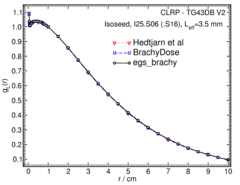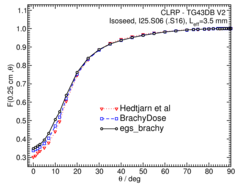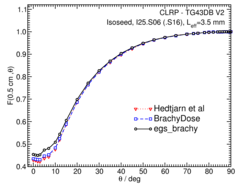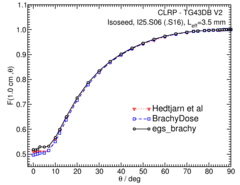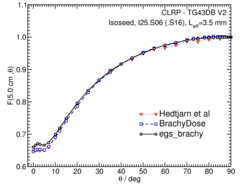
Source Description:
Seed dimensions for the I125.S06 seed are taken from the paper by Hedtjarn et al 1, Patel et al 2, and fact sheets provied by company 3 . This source consists of 125I uniformly distributed throughout a hollow cylindrical alumina (Al 2 O 3) core with inner and outer diameters of 0.220 mm and 0.60 mm, respectively. For the purpose of these calculations the amount of 125I present in the alumina is assumed to be negligible. Within the core is a 3.50 mm long gold rod with a diameter of 0.170 mm. (Note: the CLRPv1 database mistakenly described the gold core length as 0.350 mm). The core is encapsulated in a titanium tube with 0.050 mm thick walls and 0.80 mm outer diameter. (Note: The CLRPv1 database considered the end welds as slightly concave with a thickness of 0.440 mm in the middle). End welds are modelled using a 0.40 mm (radius) Ti hemisphere overlapped with a 0.889 mm air sphere with its center shifted by 0.889 mm relative to the Ti sphere (Note: the CLRPv1 database mistakenly described the air sphere center as shifted by 0.969 mm). The overall source length is 4.50 mm (Note: 4.56 mm in CLRPv1 database) and the active length is 3.50 mm. The cylindrical source element is free to move roughly 0.10 mm along the seed axis and 0.050 mm radially from the center of the seed but it is taken as centred for the present calculations. The mean photon energy calculated on the surface of the source is 28.16 keV with statistical uncertainties < 0.028%. The S16 model is the same as S06 source model, except that the amount of radioactivity is much higher (25 mCi) 3.
Dose-Rate Constant - Λ :
Dose-rate constants, Λ , are calculated by dividing the dose to water per history in a (0.1 mm)3 voxel centered on the reference position, (1 cm,Π/2), in a 30x30x30 cm3 water phantom, by the air-kerma strength per history (scored in vacuo). As described in ref. 4 , dose-rate constants are provided for air-kerma strength calculated using voxels of 2.66x2.66x0.05 cm3 (WAFAC) and 0.1x0.1x0.05 cm3 (point) located 10 cm from the source. The larger voxel size averages the air kerma per history over a region covering roughly the same solid angle subtended by the primary collimator of the WAFAC 5,6 at NIST used for calibrating low-energy brachytherapy sources and is likely the most clinically relevant value. The small voxel serves to estimate the air kerma per history at a point on the transverse axis and includes a small 1/r2 correction (0.5%)4. MC uncertainties are only statistical uncertainties (k=1).
Note*: Results from Taylor and Rogers for this seed mistakenly included a cylindrical shell of water around the seed in air-kerma calculations. This increased their DRC value.
| Author | Method | Λ (cGy h-1 U-1) | Abs. Uncertainty |
| Safigholi et al 7 | WAFAC | 1.0034 | 0.0001 |
| Safigholi et al 7 | point | 1.0040 | 0.002 |
| Taylor, Rogers 8 | WAFAC | 1.011* | 0.002 |
| Taylor, Rogers 8 | point | 1.016* | 0.003 |
| Hedtjarn et al 1 | extrap | 1.002 | --- |
| Patel et al 2 | TLD | 1.033 | 0.066 |
| Rodriguez, Rogers 9 | TLD Revised (Patel) | 0.961 | 0.058 |
| Rodriguez, Rogers 9 | WAFAC (BrachyDose) | 1.004 | 0.015 |
| Rivard et al 10 | TG43U1 Consensus Value | 1.012 | --- |
Radial dose function - g(r):
The radial dose function, g(r), is calculated using both line and point source geometry functions and tabulated at 36 different radial distances ranging from 0.05 cm to 10 cm. Fit parameters for a modified polynomial expression are also provided 11 . The mean residual deviations from the actual data for the best fit were < 0.07%.
| Fitting coefficients for g L (r) = (a0 r-2 + a1 r-1 + a2 + a3r + a4r2 + a5 r3) e-a6r | |||
| Fit range | Coefficients | ||
| r min (cm) | r max (cm) | ||
| 0.05 | 10.0 | a0 / cm2 | (6.99+/-0.13)E-04 |
| a1 / cm | (-1.344+/-0.027)E-02 | ||
| a2 | (1.0702+/-0.0013)E+00 | ||
| a3 / cm-1 | (4.833+/-0.034)E-01 | ||
| a4 / cm-2 | (-8+/-4)E-04 | ||
| a5 / cm-3 | (1.64+/-0.06)E-03 | ||
| a6 / cm-1 | (4.350+/-0.018)E-01 | ||
Anisotropy function - F(r,θ):
Anisotropy functions are calculated using the line source approximation and tabulated at radii of 0.1, 0.15, 0.25, 0.5, 0.75, 1, 2, 3, 4, 5, 7.5 and 10 cm and 32 unique polar angles with a minimum resolution of 5 o . The anisotropy factor, φ an (r), was calculated by integrating the solid angle weighted dose rate over 0 o ≤ ϑ ≤ 90 o .
Tabulated data:
Tabulated data are available in .xlsx format: Excel
References:
1. H. Hedtjarn et al , Monte Carlo-aided dosimetry of the symmetra model I25.S06 I125 , interstitial brachytherapy seed, Med. Phys., 27 , 1076-1085, 2000
2. N. S. Patel et al , Thermoluminescent dosimetry of the Symmetra 125 I model I25.S06 interstitial brachytherapy seed, Med. Phys., 28 , 1761-1769, 2001
3. I-125 Ophthalmic Seeds, individual eye tumor treatment with COMS eye applicators,Ecert & Ziegler, www.bebig.com. 4. R. E. P. Taylor et al , Benchmarking BrachyDose: voxel-based EGSnrc Monte Carlo calculations of TG-43 dosimetry parameters, Med. Phys., 34 , 445 - 457, 2007
5. R. Loevinger, Wide-angle free-air chamber for calibration of low-energy brachytherapy sources, Med. Phys., 20 , 907, 1993
6. S. M Seltzer et al , New National Air-Kerma-Strength Standards for 125I and 103Pd Brachytherapy Seeds, J. Res. Natl. Inst. Stand. Technol., 108 , 337 - 358, 2003
7. H. Safigholi, M. J. P. Chamberland, R. E. P. Taylor, C. H. Allen, M. P. Martinov, D. W. O. Rogers, and R. M. Thomson, Update of the CLRP TG-43 parameter database for the brachytherapy, to be published (Current calculation) 8.R.E.P. Taylor, D. W. O. Rogers, An EGSnrc Monte Carlo-calculated database of TG-43 parameters, Med. Phys., 35 , 4228-4241, 2008
9. Rodriguez , D. W. O. Rogers, Effect of improved TLD dosimetry on the determination of dose rate constants for 125I and 103Pd brachytherapyseeds,Med.Phys.41, 114301-15, 2014 10. M. J. Rivard et al , Update of AAPM Task Group No. 43 Report: A revised AAPM protocol for brachytherapy dose calculations, Med. Phys., 31 , 633-674, 2004
11. R. E. P. Taylor, D. W. O. Rogers, More accurate fitting of 125I and 103Pd radial dose functions, Med. Phys., 35 , 4242-4250, 2008
